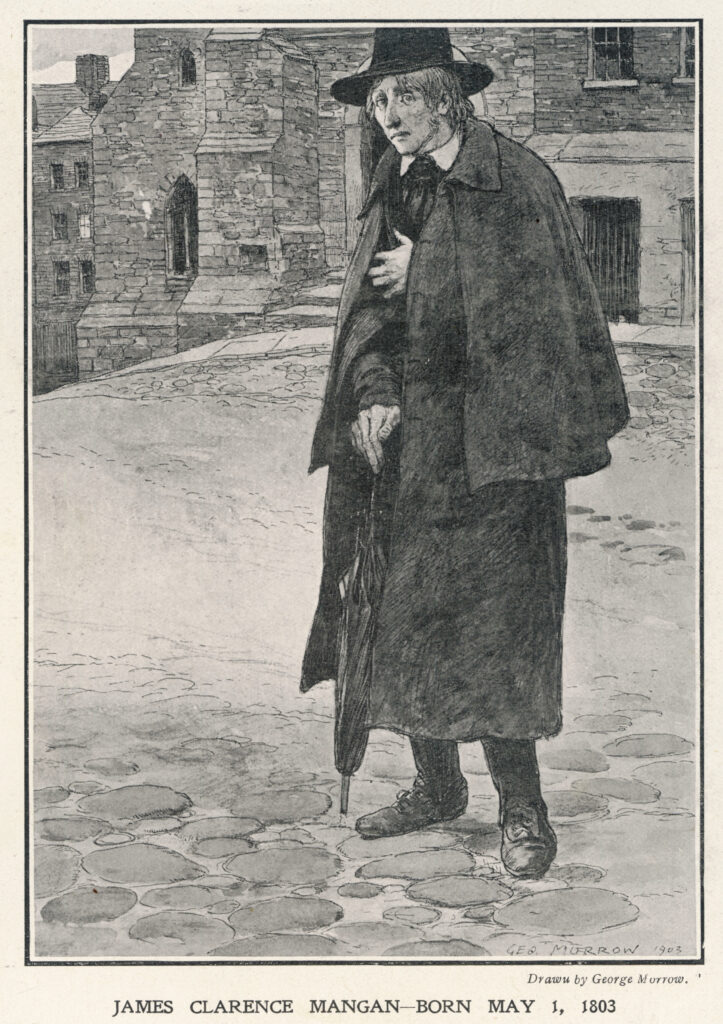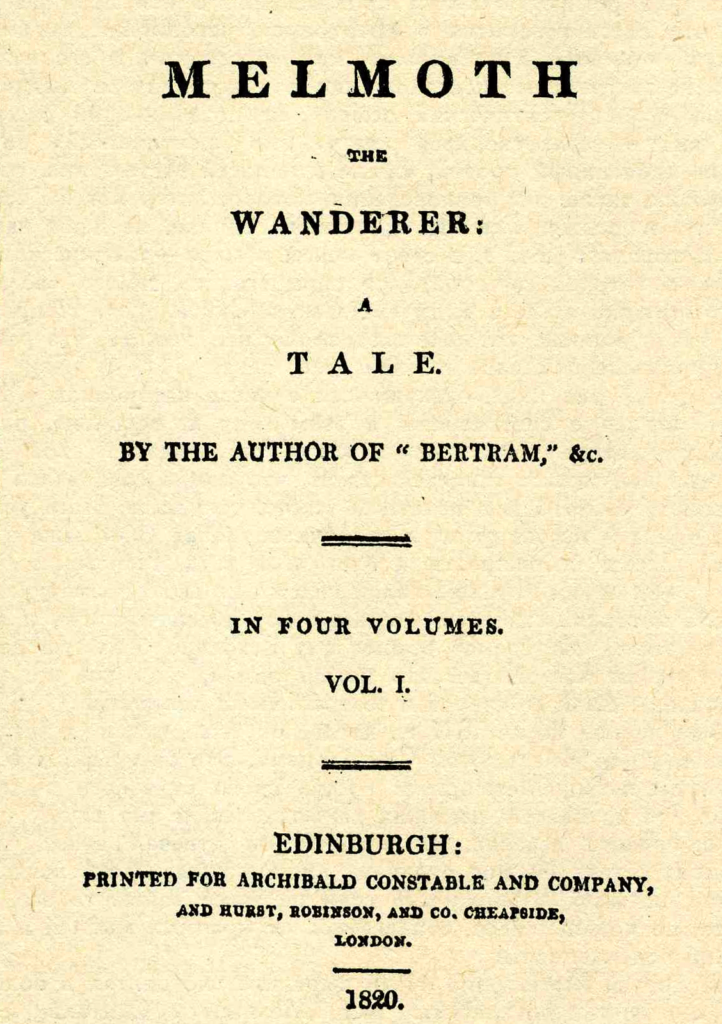

“Editor’s Note”
As a whole, I like to think that The Green Book serves as a sort of portrait of Irish Gothic literature in its myriad guises, incomplete though it may be, but ever adding detail to the canvas. Looking over this issue, I feel that most of what has been assembled here are portraits of the proprietors of the darker fantastic—some of the pieces are direct reminiscences, others illustrate their subjects in more oblique ways. I like when this happens—when the themes of an issue, or even just an approach, emerge of their own accord.
The opening triptych of portraits in this issue comes courtesy of the thunder-scarred poet James Clarence Mangan (1803-1849), whose beckoning and forlorn visage also adorns this issue’s cover. Those of you who pay attention to such things, take note that 30 October will be the 200th anniversary of Charles Maturin’s death (1782-1824). Mangan’s reminiscence of the author of Melmoth the Wanderer (1820) makes for a colourful portrayal; it strikes me now as I read it that this piece is the touchstone for how we now perceive Maturin, with all his eccentricities and swiftly underappreciated Gothic legacy. Maturin’s final resting place seems to be something of a mystery. I won’t speculate here, but if any reader wishes to conduct an investigation—and write up their findings for The Green Book—please do.
Mangan also writes on his contemporary, John Anster (1793-1862), who is best remembered today for his English translation of Goethe’s Faust, later used in the 1925 edition illustrated by Harry Clarke. In his third sketch, Mangan gives us a brief critical overview of the oeuvre of Maria Edgeworth (1768-1849), though oddly does not mention Castle Rackrent (1800). This omission is a fascinating one and a reminder that the work of an author which we today hold in the highest regard, might not be the book for which they were celebrated during their lifetime or at the time of their death—after all, when was the last time you read Bram Stoker’s Reminiscences of Sir Henry Irving, much lauded in the weeks following 20 April 1912?
 A brief side note, albeit a morbid one: Mangan penned an addendum noting that Edgeworth died during the composition of his sketch. Edgeworth died on 22 May 1849; the sketch was published on the 26th of the same month; Mangan himself scarcely survived another month, dying on 20 June 1849. Edgeworth was buried in the churchyard at St. John’s in Edgeworthstown; Mangan rests in Glasnevin Cemetery on the northside of Dublin.
A brief side note, albeit a morbid one: Mangan penned an addendum noting that Edgeworth died during the composition of his sketch. Edgeworth died on 22 May 1849; the sketch was published on the 26th of the same month; Mangan himself scarcely survived another month, dying on 20 June 1849. Edgeworth was buried in the churchyard at St. John’s in Edgeworthstown; Mangan rests in Glasnevin Cemetery on the northside of Dublin.
There is much else to explore in this issue, each article illuminating in different ways its subject. Helen C. Black gives us a bucolic interview with Charlotte Riddell—wonderfully capturing the latter’s personality; while John P. Irish and Douglas A. Anderson each explore aspects of Fitz-James O’Brien’s writing: the former examines a pair of O’Brien’s most popular tales through the lens of mad science, while the latter reconsiders a clutch of stories in the light of recent bibliographic scholarship.
An unfinished canvas comes to us from Richard Bleiler, who has unearthed more biographical information (and a previously unpublished poem) by the enigmatic “Keith Fleming”—Kathleen Fitz-Patrick (1849-1945)—author of Can Such Things Be? (1889) and By the Night Express (1889). There’s an exploration of George William Russell’s mystical transformation into “A.E.”; and finally a trio of pieces by Mervyn Wall, including his dazzling reminiscences of mid-century Dublin’s literary milieu, and his encounter with Gerald Gardner at the Museum of Witchcraft while on holiday in the Isle of Man.
On a final note, I would like to dedicate this issue of The Green Book to the memory of David J. Skal, a writer, scholar and friend who was no stranger to these pages. You might have your own favourites, but of his books, these are mine: The Monster Show, Dark Carnival, Death Makes a Holiday, and Something in the Blood. You can find David’s scholarship in The Green Book issues two, four, and six, the latter of which contains a lengthy interview with him. Thank you for the inspiration, David. Rest easy—and keep doing the Monster Mash wherever you are!
Brian J. Showers
Æon House, Dublin
16 January 2024


 EDITOR’S NOTE
EDITOR’S NOTE


 In compiling this anthology of strange tales, we sought stories by Irish women writing in the broader range of the darkly fantastic. We focused on the merits of each writer and their contribution, arranging stories in a sequence that we hope makes for an agreeable read. As one might expect, these selected tales reflect the diverse backgrounds, experiences, and preoccupations of each author. While there might not be a formal pedigree in the supernatural tradition, there is certainly a more ethereal sense of connection that characterises these writers and their offerings to strange literature.
In compiling this anthology of strange tales, we sought stories by Irish women writing in the broader range of the darkly fantastic. We focused on the merits of each writer and their contribution, arranging stories in a sequence that we hope makes for an agreeable read. As one might expect, these selected tales reflect the diverse backgrounds, experiences, and preoccupations of each author. While there might not be a formal pedigree in the supernatural tradition, there is certainly a more ethereal sense of connection that characterises these writers and their offerings to strange literature.



 Novels and Collections
Novels and Collections If you’re interested in learning more about Charlotte Riddell, you might like to check out Issue 9 of our journal, The Green Book. In
If you’re interested in learning more about Charlotte Riddell, you might like to check out Issue 9 of our journal, The Green Book. In 
 A good while back I posted the image of a poster designed by myself and long-time Swan River conspirator Jason Zerrillo. It features a line-up of Ireland’s most recognisable and possibly most influential writers of fantastic literature. I explained the impetus for the poster’s creation in an earlier
A good while back I posted the image of a poster designed by myself and long-time Swan River conspirator Jason Zerrillo. It features a line-up of Ireland’s most recognisable and possibly most influential writers of fantastic literature. I explained the impetus for the poster’s creation in an earlier